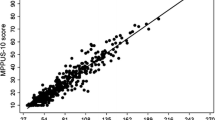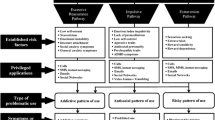Abstract
Aim
In recent years, mobile phone use has become increasingly common among Italian youth, while a growing scientific literature has been identifying the occurrence of a problematic mobile phone use which seems to share some features of other conditions often referred to as behavioural addictions. The study aimed to assess the prevalence of problematic mobile phone use in a population of Italian adolescents and its association with other behavioural addictions.
Subjects and methods
The Mobile Addiction Test (MAT) was administered to 2,790 high school students from Barletta, an Italian town, together with the South Oaks Gambling Screen-Revised for Adolescents (SOGS-RA), the Compulsive Buying Scale (CBS), the Internet Addiction Test (IAT), the Exercise Addiction Inventory (EAI), the Work Addiction Risk Test (WART).
Results
MAT scores fitted a Gaussian distribution model. Scores ≥ 17 was found as a cut-off value over which identifying problematic mobile phone users. Overall prevalence of problematic mobile phone use was 6.3%; this condition was associated with other behavioural addictions like compulsive buying.
Conclusion
Problematic mobile phone use in adolescence should become a public health issue, and it could be a cause of health problems and social costs.

Similar content being viewed by others
References
American Psychiatric Association (2000) DSM-IV-TR: diagnostic and statistical manual of mental disorders, 4th edn., text revision. American Psychiatric Association, Washington, DC
Bianchi A, Phillips JG (2005) Psychological predictors of problem mobile phone use. Cyberpsychol Behav 8:39–51
Blaszczynski A, Nower L (2002) A pathway model of problem and pathological gambling. Addiction 97:487–499
Brewer JA, Potenza MN (2008) The neurobiology and genetics of impulse control disorders: relationships to drug addictions. Biochem Pharmacol 75:63–75
Brown RIF (1993) Some contributions of the study of gambling to the study of other addictions. In: Eadington WR, Cornelius JA (eds) Gambling behaviour and problem gambling. Institute for the Study of Gambling and Commercial Gaming, Reno, pp 241–272
Di Nicola M, Tedeschi D, Mazza M et al (2010) Behavioural addictions in bipolar disorder patients: role of impulsivity and personality dimensions. J Affect Dis. doi:10.1016/j.jad.2009.12.016
Department of Health and Human Services (1994) Preventing tobacco use among young people: a report of the Surgeon General. US Government Printing Office, Washington, DC
Faber RJ, O’Guinn TC (1992) A clinical screener for compulsive buying. J Consum Res 19:459–469
Flowers CP, Robinson B (2002) A structural and discriminant analysis of the Work Addiction Risk Test. Educ Psychol Meas 62:517–526
Greenberg JL, Lewis SE, Dodd DK (1999) Overlapping addictions and self-esteem among college men and women. Addict Behav 24:565–571
Griffiths MD, Szabo A, Terry A (2005) The exercise addiction inventory: a quick and easy screening tool for health practitioners. Br J Sports Med 39:e30
Haigney DE, Westermann SJ (2001) Mobile (cellular) phone use and driving: a critical review of research methodology. Ergonomics 44:132–143
Hakala PT, Rimpela AH, Saarni LA, Salminen JJ (2006) Frequent computer-related activities increase the risk of neck-shoulder and low back pain in adolescents. Eur J Public Health 16:536–541
Hardell L, Carlberg M (2009) Mobile phones, cordless phones and the risk for brain tumours. Int J Oncol 35:5–17
Hardell L, Carlberg M, Soderqvist F, Hansson Mild K (2008) Meta-analysis of long-term mobile phone use and the association with brain tumours. Int J Oncol 32:1097–1103
Hosmer DW, Lemeshow S (1989) Applied logistic regression. Wiley, New York
Hyun Ha J, Chin B, Park DH, Ryu SH, Yu J (2008) Characteristics of excessive cellular phone use in Korean adolescents. Cyberpsychol Behav 11:783–784
Istituto Nazionale di Statistica (2008) La vita quotidiana di bambini e ragazzi Anno 2008. ISTAT, Roma
Johnston LD, O’Malley PM, Bachman JG, Schulenberg JE (2005) Monitoring the future national survey results on drug use, 1975–2004. National Institute on Drug Abuse, Bethesda, MD
Jurewicz J, Hanke W, Radwan M, Bonde JP (2009) Environmental factors and semen quality. Int J Occup Med Environ Health 22:305–329
Koran LM, Faber RJ, Aboujaoude E, Large MD, Serpe RT (2006) Estimated prevalence of compulsive buying behaviour in the United States. Am J Psychiatry 163:1806–1812
Kundi M (2010) Mobile phone use and brain cancer: is the association biased? Neuroepidemiology 35:115–116
Ladouceur R, Bouchard C, Rheaume Jacques C, Ferland F, Leblond J, Walker M (2000) Is the SOGS an accurate measure of pathological gambling among children, adolescents, and adults? J Gambl Stud 16:1–21
Lesieur H, Blume SB (1987) The South Oaks Gambling Screen (SOGS): a new instrument for the identification of pathological gamblers. Am J Psychiatry 144:1184–8
Marcelli D, Braconnier A (2004) Adolescence et psychopathologie, 6e édition revue et completéeth edn. Masson, Paris
Meo SA, Al-Drees AM (2005) Mobile phone related-hazards and subjective hearing and vision problems in the Saudi population. Int J Occup Med Environ Health 18:53–57
Messerlian C, Derevensky J, Gupta R (2005) Youth gambling problems: a public health perspective. Health Promot Int 20:69–79
Paulus P (2007) 20 years of health promotion research in and on setting in Europe: the case of school health promotion. Ital J Public Health 4:248–254
Petry NM, Stinson FS, Grant BF (2005) Comorbidity of DSM-IV Pathological Gambling and other psychiatric disorders: results from the National Epidemiologic Survey on Alcohol and Related Conditions. J Clin Psychiatry 66:564–574
Poulin C (2002) An assessment of the validity and reliability of the SOGS-RA. J Gambl Stud 18:67–93
Redelmeier DA, Tibshirani RJ (1997) Association between cellular telephone calls and motor vehicle collisions. N Engl J Med 336:453–458
Roberts JA (1998) Compulsive buying among college students: an investigation of its antecedents, consequences, and implications for public policy. J Consum Aff 32:295–319
Robinson BE (1989) Work addiction. Health Communications, Dearfield Beach, FL
Robinson BE (1996) Concurrent validity of the Work Addiction Risk Test as a measure of workaholism. Psychol Rep 79:1313–1314
Robinson BE (1999) The Work Addiction Risk Test: development of a tentative measure of workaholism. Percept Mot Skills 88:1999–2010
Robinson BE, Post P (1994) Validity of the Work Addiction Risk Test. Percept Mot Skills 78:337–338
Robinson BE, Post P, Khakee JF (1992) Test-retest reliability of the Work Addiction Risk Test. Percept Mot Skills 74:926
Rutland JB, Sheets T, Young T (2007) Development of a scale to measure problem use of short message service: the SMS problem use diagnostic questionnaire. Cyberpsychol Behav 10:841–843
Schepis TS, Adinoff B, Rao U (2008) Neurobiological processes in adolescent addictive disorders. Am J Addict 17:6–23
Selwyn N (2003) Schooling the mobile generation: the future for schools in the mobile-networked society. Br J Sociol Educ 24:131–144
Shaffer HJ, Hall MN, Vander Bilt J (1999) Estimating the prevalence of disordered gambling behaviour in the United States and Canada: a research synthesis. Am J Public Health 89:1369–1376
Ship AN (2010) The most of primary care: talking about driving and distraction. N Engl J Med 362:2145–2147
Simonelli F, Fernandes Guerreiro AI, Simonelli I, di Pasquale C (2010) Six assertions about the salutogenic approach and health promotion. Ital J Public Health 7:94–101
SIIPaC (Società Italiana Intervento Patologie Compulsive) (2010) Mobile Addiction Test. www.siipac.it. Cited 03 June 2010
Takao M, Takahashi S, Kitamura M (2009) Addictive personality and problematic mobile phone use. Cyberpsychol Behav 12:501–507
Terry A, Szabo A, Griffiths M (2004) The exercise addiction inventory: a new brief screening tool. Addict Res Theory 12:489–499
Villella C, Martinotti G, Di Nicola M et al (2010). Behavioural addictions in adolescents and young adults: results from a prevalence study. J Gambl Stud. doi:10.1007/s10899-010-9206-0
Walsh SP, White KM, Young RM (2008) Over-connected? A qualitative exploration of the relationship between Australian youth and their mobile phones. J Adolesc 31:77–92
Widyanto L, McMurran M (2004) The psychometric properties of the Internet addiction test. Cyberpsychol Behav 7:443–450
Winters KC, Stinchfield RD, Fulkerson J (1993a) Toward the development of an adolescent gambling problem severity scale. J Gambl Stud 9:63–84
Winters KC, Stinchfield RD, Fulkerson J (1993b) Patterns and characteristics of adolescent gambling. J Gambl Stud 9:371–386
Winters KC, Stinchfield RD, Kim LG (1995) Monitoring adolescent gambling in Minnesota. J Gambl Stud 11:165–183
World Medical Association (2009) World Medical Association Declaration of Helsinki Ethical Principles for Medical Research Involving Human Subjects. World Med J 55:2–4
Yen CF, Tang TC, Yen JY et al (2009) Symptoms of problematic cellular phone use, functional impairment and its association with depression among adolescents in southern Taiwan. J Adolesc 32:863–873
Young KS (1998) Caught in the net. Wiley, New York
Funding
None
Conflict of Interest
The authors declare that they have no conflict of interest.
Ethical approval
The study protocol complied fully with the guidelines of the Ethics Committee of the Catholic University of Rome, and was approved by the Institutional Review Boards in accordance with local requirements. It was conducted in accordance with Good Clinical Practice guidelines and the Declaration of Helsinki.
Author information
Authors and Affiliations
Corresponding author
Rights and permissions
About this article
Cite this article
Martinotti, G., Villella, C., Di Thiene, D. et al. Problematic mobile phone use in adolescence: a cross-sectional study. J Public Health 19, 545–551 (2011). https://doi.org/10.1007/s10389-011-0422-6
Received:
Accepted:
Published:
Issue Date:
DOI: https://doi.org/10.1007/s10389-011-0422-6




